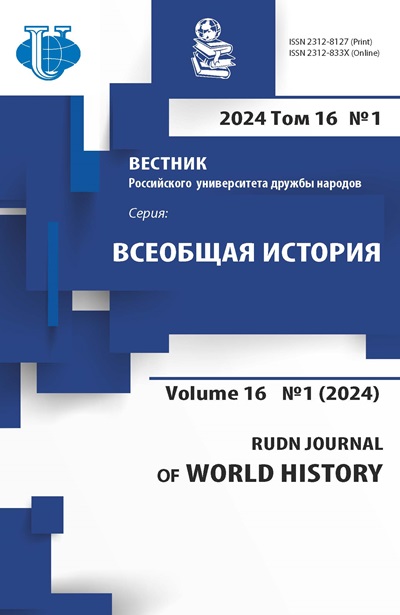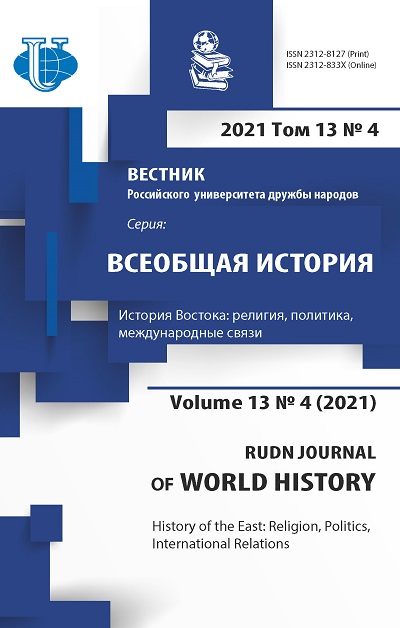Disputes over the permissibility of tobacco smoking among the ulama of Ottoman Syria
- Authors: Krayushkin N.R.1
-
Affiliations:
- Institute of Oriental Studies of Russian Academy of Sciences
- Issue: Vol 13, No 4 (2021): History of the East: religion, politics, international relations
- Pages: 363-373
- Section: Religion and Politics in the Middle East
- URL: https://journals.rudn.ru/world-history/article/view/29419
- DOI: https://doi.org/10.22363/2312-8127-2021-13-4-363-373
Cite item
Full Text
Abstract
The article analyzes the history of tobacco smoking in Great Syria of the 17th - mid-18th centuries. The consumption of tobacco, brought to the Ottoman Empire by European merchants from the New World, began to spread rapidly among various groups of society, including women and children. The popularity of the new habit caused a wary attitude to it of the Ottoman theologians from the Turkish Kadizadeli movement. In the middle of the 17th century, they managed to achieve significant influence on the sultan’s court and banned tobacco smoking in the Ottoman Empire for a while. However, after the unsuccessful military campaign of the Turks initiated by the Kadizadeli near Vienna in 1683, the Hanafi “Puritans” of Islam were expelled from the capital. This time, they chose Greater Syria as one of the main strongholds of the movement. In Damascus, the question of the legality of tobacco smoking from the point of view of the norms of Islamic law was defended by Sufis under the leadership of the Syrian mystic ʻAbd al-Ghani al-Nablusi. As a result of the disputes, the Kadizadeli lost their influence in Syria, which partly contributed to the further rejection by the inhabitants of the region of another “Puritanical” movement in Islam, led by Muhammad ibn ʻAbd al-Wahhab.
About the authors
Nikita Romanovich Krayushkin
Institute of Oriental Studies of Russian Academy of Sciences
Author for correspondence.
Email: kranr@mail.ru
PhD in History, Research Fellow, Center for Arabic and Islamic Studies
12/1 Rozhdestvenka street, Moscow, Russian Federation, 107031References
- Curry J. The Transformation of Muslim Mystical Thought in the Ottoman Empire: The Rise of the Halveti Order, 1350–1650. Edinburgh: Edinburgh University Press; 2010.
- Al-Nablusi ‘Abd al-Ghani. Al-Sulh bayn al-ihwan fi hukm ibahat al-duhan [Reconciliation between brothers on the issue of the permissibility of tobacco smoking]. Damascus: Ninawa li-l-dirasa wa-l-nashr; 2015. (In Arab.).
- Mez A. Musulmanskii Renessans [The Muslim Renaissance]. Moscow: ViM; 1996. (In Russ.).
- Trimingham JS. Sufiiskie ordeni v islame [The Sufi Orders in Islam]. Moscow: Nauka; 1989. (In Russ.).
- Al-Nablusi ‘Abd al-Ghani. Hullat al-zahab al-ibriz fi rihlat Ba‘labakk va-l‘-Bika‘ al-‘aziz [Golden robes of a trip to Baalbek and the sacred Bekaa Valley] (manuscript). Available from: https://www.alukah.net/library/0/125052/ [Accessed 05.12.2019]. (In Arab.).
- Baram Uzi. Entangled Objects from the Palestinian Past: Archaeological Perspectives for the Ottoman Period, 1500–1900. A Historical Archaeology of the Ottoman Empire: Breaking New Ground. New York: Kluwer Academic Publishers; 2002, р. 137–160.
- Hinz W. Musulmanskie mery i vesa s perevodom v metricheskuyu sistemu [Muslim measures and weights with translation into the metric system]. Moscow: Nauka; 1970. (In Russ.).
- Grehan J. Everyday Life and Consumer Culture in 18th Century Damascus. Seattle: University of Washington Press; 2007.
- An Ottoman Traveller: Selections from the Book of Travels of Evliya Çelebi. Transl. and comment. by Robert Dankoff and Sooyong Kim. London: Eland; 2011.
- Al-Budairi Ahmad. Hawadith Dimashk al-iawmiia [Daily events of Damascus]. Kair; 1959. (In Arab.).
- Al-Muhibbi Muhammad Amin. Hulasat al-athar fi a‘jan al-karn al-hadi ‘ashar [Biographies of noble persons of the 11th century according to the Muslim chronology]. Vol. 1. Beirut: Dar al-qutub al-’ilmiyya; 2006. (In Arab.).
- Al-Nablusi ‘Abd al-Ghani. Al-Haqiqa va-l-madzhaz fi-l-rihla ila bilad al-Sham va Misr va-l-Hidzhaz [A reliable and imaginative description of a journey through Great Syria, Egypt and the Hejaz]. Cairo: Markaz Tausik al-turas, al-Haja al-misriшa al-‘amma li-l-kitab; 1986. (In Arab.).
- Birgivi Imam. The Path of Muhammad (al-Tariqah al-Muhammadiyyah): A Book on Islamic Morals and Ethics. Bloomington: World Wisdom; 2005.
- Cook M. Commanding Right and Forbidding Wrong in Islamic Thought. Cambridge: Cambridge University Press; 2004.
- Baer MD. Honored by the Glory of Islam: Conversion and Conquest in Ottoman Europe. Oxford: Oxford University Press; 2008.
- Çelebi Kȃtip, Hacı Halife. The Balance of Truth. Trans. Geoffrey L. Lewis. London: George Allen and Unwin; 1957.
- Al-Nablusi ‘Abd al-Ghani. Al-Hadra al-unsiia fi-l-rihla al-kudsiia [A friendly message about the Jerusalem trip]. Beirut: al-Masader; 1990. (In Arab.).
- Kahhala ‘Umar Rida. Mu‘dzham al-mu’allifin: taradzhim musannifi al-kutub al-‘arabiia [Biographical dictionary of Arabic authors]. Beirut: Mu’assasat al-risala; 1993. (In Arab.).
- Al-Muradi Halil. Silk ad-durar fi a‘jan al-karn as-sani ‘ashar [The Pearl Way of the nobles of the 12th century]. Vol. 2. Bulak: al-Matba‘a al-misriia al-‘amira bi-Bulak; 1884. (In Arab.).
- Al-Nablusi ‘Abd al-Ghani. Al-Tuhfa al-nablusiia fi-l-rihla al-tarabulusiia [The Nablus Gift of the trip to Tripoli]. Beirut: Maktabat al-thaqafa al-diniia, n/y. (In Arab.).













